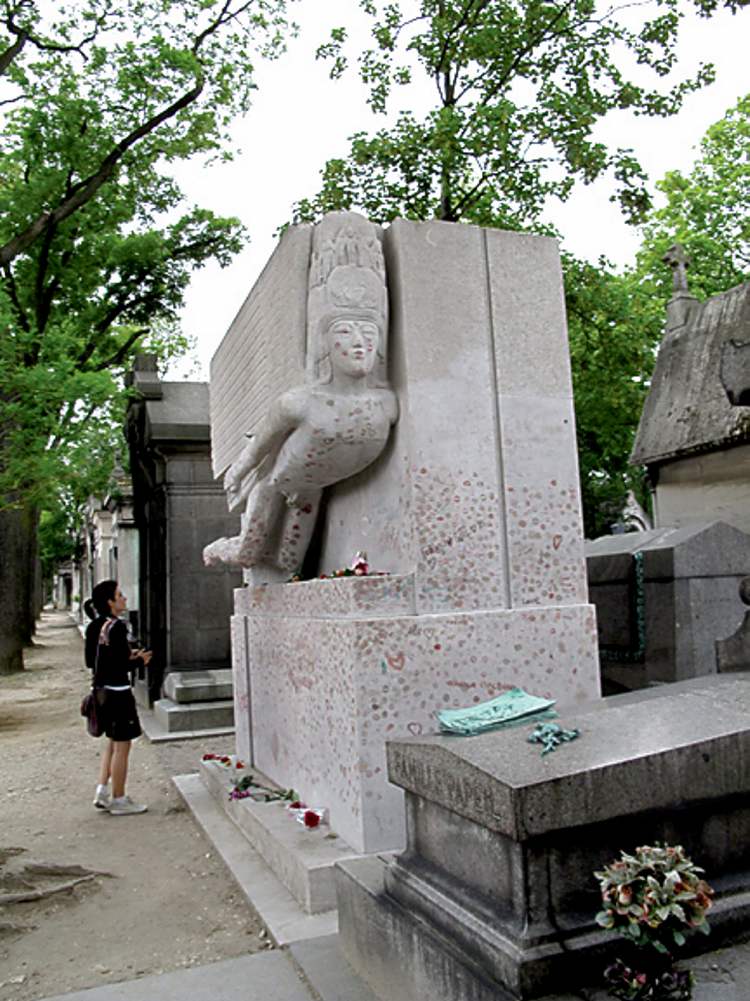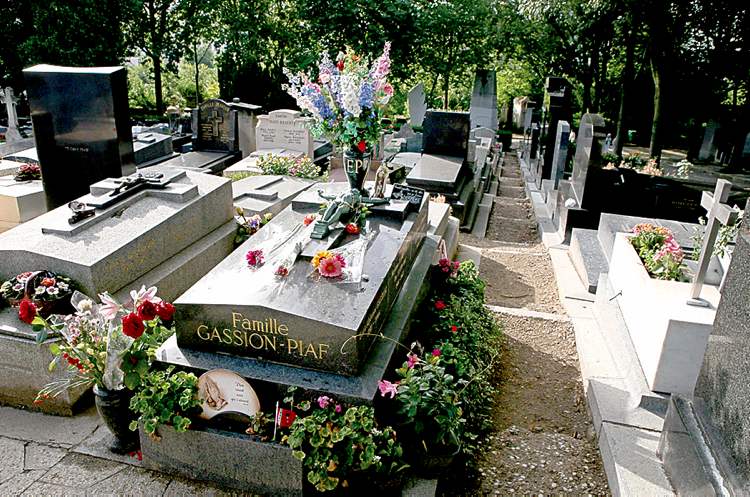Famous lovers, legendary graves
Parisian cemetery home to doomed lovers, musicians
Advertisement
Read this article for free:
or
Already have an account? Log in here »
To continue reading, please subscribe:
Monthly Digital Subscription
$1 per week for 24 weeks*
- Enjoy unlimited reading on winnipegfreepress.com
- Read the E-Edition, our digital replica newspaper
- Access News Break, our award-winning app
- Play interactive puzzles
*Billed as $4.00 plus GST every four weeks. After 24 weeks, price increases to the regular rate of $19.00 plus GST every four weeks. Offer available to new and qualified returning subscribers only. Cancel any time.
Monthly Digital Subscription
$4.75/week*
- Enjoy unlimited reading on winnipegfreepress.com
- Read the E-Edition, our digital replica newspaper
- Access News Break, our award-winning app
- Play interactive puzzles
*Billed as $19 plus GST every four weeks. Cancel any time.
To continue reading, please subscribe:
Add Free Press access to your Brandon Sun subscription for only an additional
$1 for the first 4 weeks*
*Your next subscription payment will increase by $1.00 and you will be charged $16.99 plus GST for four weeks. After four weeks, your payment will increase to $23.99 plus GST every four weeks.
Read unlimited articles for free today:
or
Already have an account? Log in here »
Hey there, time traveller!
This article was published 31/03/2012 (4946 days ago), so information in it may no longer be current.
Love after death in Paris; Crowds, candles and flowers symbols of the enduring fame of Pere Lachaise’s “residents”
Some people just never lose their mojo.

In Paris, some of the world’s most famous lovers still draw crowds long after their expiry date. Photographers jostle for a clear shot while fences keep back the more rabid fans. Lipstick prints, melted candles and love letters are left behind by throngs of admirers.
Over two million people a year come to visit the last addresses of the famous and notorious in Pere Lachaise Cemetery, making it the most visited cemetery in the world.
It wasn’t always so popular. In 1804, the grounds were purchased from Louis XIV’s confessor Pere de Lachaise D’Aix by Napoleon’s government because the mass graves in the city centre were literally full to bursting and emitting some very unrefined odours.
Pere Lachaise was considered just a bit too far out of the way for most Parisians until Napoleon had the bodies of a few stars disinterred and moved onto the grounds. It was a brilliant marketing ploy and before long people were dying to get in. Among the first notables to be relocated were the playwright Moliere and the lovers Abelard and Heloise.
If you plan to visit the storied cemetery, here are a few notable gravesites on the must-see list:
Peter Abelard (1079-1142) and Heloise (1101-1164):
The tragic story of Abelard and Heloise is a tale of love interrupted. He was a philosopher and theologian who set up his own school at the age of 22, which later became the University of Paris. At 36, at the height of his intellectual power and fame, he met Heloise. She was only 13, but she was already an acclaimed scholar, and her uncle was persuaded to let Abelard become her tutor. Abelard found her beauty and brains irresistible, and they became lovers until, at the age of 16, she gave birth to their son, Astrolabe, and they were forced to marry in secret.
Outraged by the affair, her uncle hired thugs to break into Abelard’s room and castrate him. The resulting scandal ended Abelard’s career, he retreated to a monastery and eventually became a hermit. Heloise was coerced into entering a convent against her wishes. She spent the rest of her life as a nun, but she never stopped loving Abelard. Their letters to each other are a study in torment and devotion as they tried to reconcile the fate that had pulled them apart with their duty to the church. Pursued by his enemies and on trial for heresy, Abelard died in Rome. Heloise died 20 years later, a respected abbess.
Sidonie-Gabrielle Colette (1873-1954):
The next “must see” for fixated fans in 2010 may be the grave of Colette, the bisexual novelist buried in Division 4. At 20, she married the infamous “Willy,” a man 15 years her senior, who locked her in her room each day until she wrote her quota of pages, which he then published as books under his own name.
Fed up with this treatment and his infidelities, she left him and moved in with the American writer Natalie Barney. This was the first of a series of affairs with the likes of Josephine Baker, the famous burlesque artist, and Mathilde de Momy, her guide into the world of Paris music halls.
Onstage, she had her first “wardrobe malfunction” 100 years before Janet Jackson, and a kiss between her and Mathilde at the Moulin Rouge in 1907 caused a riot. Shades of Madonna and Britney!

In 1912, she married a newspaper editor and had a daughter, but her affair with her stepson ended the marriage. The result was a semi-autobiographical novel of a liaison between an older woman and a younger man, adapted in the recently released movie Cheri, starring Michelle Pfeiffer. Colette wrote more than 50 novels and published Gigi in 1944 when she was 72. That film won the Academy Award for Best Picture in 1958.
Of all her loves, she liked cats the best,and legend has it that cats replenish the roses on her grave.
Jim Morrison (1943-71):
The man who single-handedly caused a shortage of leather pants in the 1960s is buried in one of the few fenced plots. As the lead singer of the Doors, Morrison was the epitome of rock star excess. His open drug use, sexual flamboyance and nihilistic attitude led to run-ins with the police that culminated in his arrest for public indecency.
Hoping to flee the United States for a quiet life, he was living incognito in Paris as a writer until his mysterious death at 27, from a rumoured drug overdose or a weakened heart (the official story). His tomb used to display a bust of the singer, but devotees just couldn’t keep their hands off the statue or their pants on after dark. As a result, his grave lost a statue and gained a security guard. That doesn’t stop the love letters, poetry, candles and flowers from piling up on his grave.
Oscar Wilde (1854-1900):
This tomb may hold the record for most lipstick kisses. The celebrated playwright, poet, author and defender of the “love that dare not speak its name” was jailed for two years for gross indecency and died in Paris a broken man. Before he died, he said, “My wallpaper and I are fighting a duel to the death. One of us has got to go.”
The artist Modigliani and his lover Jeanne Hebuterne are buried here. She was nine months pregnant when she threw herself out a window upon hearing that he had died of meningitis.
Not all lovers met a tragic end, though. Gertrude Stein and Alice B. Toklas share a headstone in Division 94. Simone Signoret and Yves Montand, stars of the French cinema, are resting in Division 44 after a long and happy marriage.
Allow about two hours to pay your respects, then head for a café across the street, raise a glass and toast to being alive in Paris.

— Postmedia News
IF YOU GO
Pere Lachaise cemetery at 16 Rue du Repos, Paris, is located between the 11th and 20th arrondissements in the Belleville area. Belleville is a traditionally working-class neighbourhood which has been undergoing gentrification lately, so you’ll find a mix of African, Asian, Italian and traditional French shops, restaurants and cafes on the streets around the grounds. Walking through Pere Lachaise is like visiting a miniature Parisian village. Narrow streets and avenues lead to tree-lined squares with splashing fountains. Look for the small cast-iron street signs that will guide you through the 97 divisions and over 70,000 gravesites.
– Getting There: Metro stops are Gambetta and Pere Lachaise.
– Hours: The cemetery is open from Mar. 16 to Nov. 5 from 8 a.m. to 6 p.m. Monday to Friday and 8:30 a.m. to 6 p.m. on Saturday; Sundays and holidays 9 a.m. to 6 p.m. the cemetery closes a half-hour earlier during the winter season, Nov. 6 to Mar. 15. last entry is 15 minutes before closing. Admission is free.
– Maps are available at surrounding florists and on the street from vendors, but the free map available at the conservation office will give you just as much information and is easy to follow.
– Tours in English run sporadically in the summer. Call 01 55 25 82 10 in Paris to confirm times.

